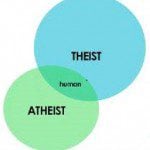We believe that Jesus died and rose again. ~ 1 Thessalonians 4:14
This summarizes the astonishing early testimonies of the apostles and first witnesses of the Risen Lord following the first Easter. More astounding than the Incarnation, there's a magnitude about the Risen Lord's resurrection that merits our own deepest consideration.
Beyond the discovery of the empty tomb, the personal encounters with the glorified, Risen Lord Jesus Christ amazed and captivated the disciples more than the miraculously raised and resuscitated bodies of the son of the widow of Nain, Jairus' daughter, or Lazarus (Lk. 7:11-17; Mk. 5:22-24, 35-43; Jn. 11:1-44), all who were raised but eventually died again. Jesus rose, and would ascend into heaven prior to the Pentecost.
What's more, the nature of the Risen Body of Jesus has certain properties that were not easily explained. The post-resurrection accounts recall that Jesus was seemingly able to walk through walls. It was noted that he appeared and disappeared. Yet he was not a ghost dwelling in the realm of the dead, he was very much alive! There were certainly a number of times where Jesus ate food with his disciples.
No, this was not a back-from-the-dead return to the old life; this is was an entirely new life form. Recognizable to those who knew him, Jesus was transformed, possessing a distinctive change and a "definite otherness," writes Pope Benedict in his second installment of the Jesus of Nazareth book series.
Jesus' Resurrection was about breaking out into an entirely new form of life, in to a life that is no longer subject to the law of dying and becoming, but lies beyond it—a life that opens up a new dimension of human existence. Therefore the Resurrection of Jesus in not an isolated event that we could set aside as something limited to the past, but it constitutes an "evolutionary leap" (to draw an analogy, albeit one that is easily misunderstood). In Jesus' Resurrection a new possibility of human existence is attained that affects everyone and opens up a future, and new kind of future, for mankind (244).
This resurrection is a new and unprecedented dimension for humanity. It represents a kind of reconfiguration or a transformation of the body into a glorified body beyond the boundaries of what we normally conceive. In his book, the pope poses the following rational meditation for those needing a more cogent or analytic assessment of this new dimension of life.
What already exists is not called into question. Rather we are told that there is a further dimension, beyond what was previously known. Does that really contradict science? Can there really only ever be what there has always been? Can there not be something unexpected, something unimaginable, something new? If there really is a God, is he not able to create a new dimension of human existence, a new dimension of reality altogether? Is not creation actually waiting for this last and highest "evolutionary leap," for the union of the finite with the infinite, for the union of man and God, for the conquest of death? (247)
Resurrection is a reality transcending human experience both now and in the Kingdom to come. It is bears the promise of God's infinity joining with our singularity. It not only defines our Christian faith, it raises our humanity, both body and soul, to a height that has meaning beyond a single holy day or season.
Pope Benedict mentioned this transcendence again during his recent Easter Sunday blessing to Rome and the world.
The resurrection of Christ is not the fruit of speculation or mystical experience: it is an event which, while it surpasses history, nevertheless happens at a precise moment in history and leaves an indelible mark upon it. The light which dazzled the guards keeping watch over Jesus' tomb has traversed time and space. It is a different kind of light, a divine light, that has rent asunder the darkness of death and has brought to the world the splendour of God, the splendour of Truth and Goodness.
Just as the sun's rays in springtime cause the buds on the branches of the trees to sprout and open up, so the radiance that streams forth from Christ's resurrection gives strength and meaning to every human hope, to every expectation, wish and plan. (Benedict XVI, Urbi et Orbi Message, Easter 2011)
From the time of the first apostles till now, no one can fully describe what physically took place at the moment of Jesus' resurrection. That knowledge is left between the Father in Heaven and the Son. No gospel records those details. Yet, the profound transcendence of the resurrection remains the long-standing teaching of the Church through the ages to our own day (Catechism of the Catholic Church, par. 638):
The Resurrection of Jesus is the crowning truth of our faith in Christ, a faith believed and lived as the central truth by the first Christian community; handed on as fundamental by Tradition; established by the documents of the New Testament; and preached as an essential part of the Paschal mystery along with the cross:
Christ is risen from the dead!
Dying, he conquered death;
To the dead, he has given life. (Easter Troparion, Byzantine Liturgy)
4/27/2011 4:00:00 AM





